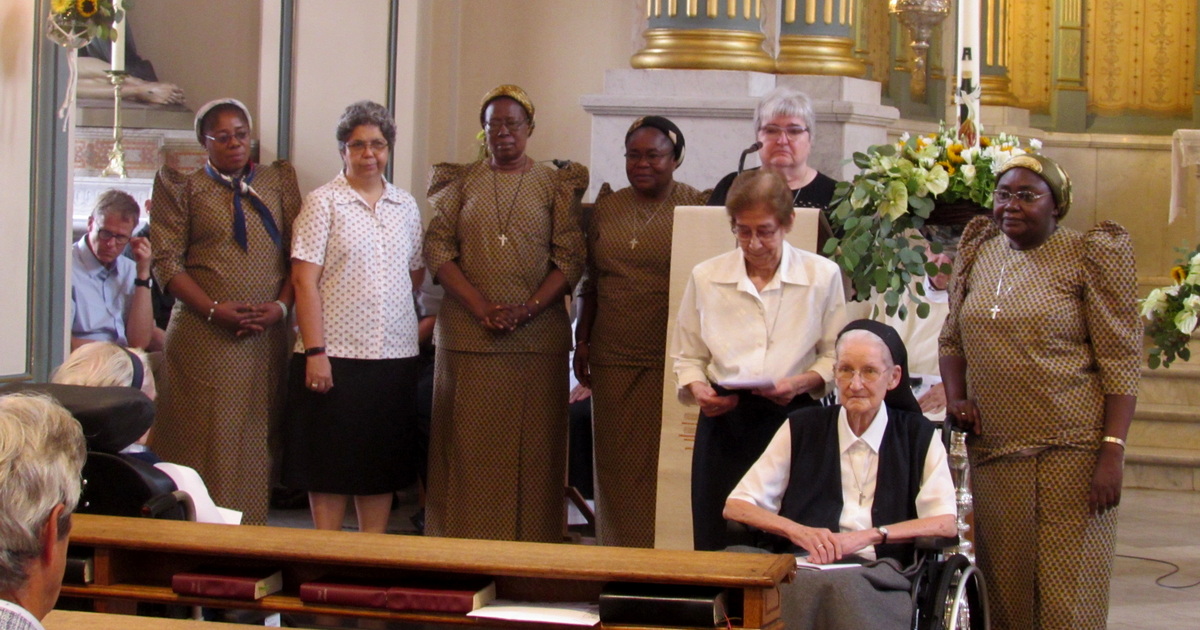Founded in 1818 by Baroness Elisabeth de Robiano, the Congregation of the Sisters of Saint Vincent de Paul, “Servants of the Poor” of Gijzegem, embodies over two centuries of dedication to spirituality, education, and healthcare, with a special focus on the poorest of the poor. Today, this religious community extends across three continents and remains faithful to the principles laid down by its founder, despite the challenges posed by a decline in vocations and the evolution of the modern world.
Origins: A Foundation Marked by Crisis
Born on July 25, 1773, in Tervuren, Elisabeth de Robiano grew up in a strict environment, shaped by the values of the nobility and the Catholic Church. At that time, Belgium was torn apart by the Brabant Revolution and the French Revolution, periods of social and political upheaval that deeply affected the young Elisabeth. From an early age, she felt a monastic calling, but family commitments, particularly after her father’s death, led her to postpone her plans.
In 1799, she married Baron Charles Lecandèle and moved into Gijzegem Castle. It was there, encouraged by her spiritual director, Monsignor De Broglie, that she began to fully dedicate herself to charitable work. The endemic poverty in the region, exacerbated by the Napoleonic Wars, motivated Elisabeth to act. Her early efforts included trying to establish a hospital and a retirement home, both of which failed due to a lack of resources. She then turned to education, recognizing it as a way to lift the younger generation out of poverty.
The Founding of the Congregation
The Congregation truly took shape in 1818 with the founding of a spinning school in Gijzegem. This school, aimed at poor children, was an immediate success beyond expectations. Alongside the baroness, Sister Barbe Cool, from the Congregation of the Sisters of Our Lady of Ten Bunderen, took charge of the institution. The school quickly became a model of social integration, welcoming children from all social classes, with wealthier students paying tuition to subsidize the education of impoverished children.
In 1819, the Congregation received its first rule of life, inspired by the spirituality of Saint Vincent de Paul and written by Jesuit Vincent Le Maître. The sisters committed to living in simplicity, humility, and love, following the precepts of their patron saint, who remains central to their mission. These values became embedded in the identity of the Congregation, reflected in their daily prayers, educational work, and care for the sick.
Expansion and Challenges in the 19th Century
Initially centered in the Gijzegem region, the Congregation began expanding throughout Belgium in the 1830s. This growth was facilitated by Belgium’s independence in 1830, which provided a more stable context for the development of religious institutions. In 1835, the first sisters took their perpetual vows, solidifying their lifelong commitment to serving the poor. The rapid growth of the community, which had 45 sisters by 1823, necessitated a move to a larger complex in Gijzegem.
By the time Elisabeth de Robiano passed away in 1864, the Congregation had already spread across four Belgian dioceses and counted 222 sisters in 32 communities. This success was due to the founder’s dedication, as well as that of her successors, including Sister Marie-Louise De Wilde, who was elected the first Superior General after the baroness’s death.
The Mission Era: International Expansion and Peak
The turn of the 20th century marked a new phase in the history of the Sisters of Gijzegem: the mission era. In 1896, the first sisters departed for Brazil, establishing themselves in Olinda and later São Paulo. This first mission post marked the beginning of a long tradition of international engagement, which continued in 1930 with the opening of a mission in the Congo, at Vaku. These efforts allowed the Congregation to expand beyond European borders, strengthening its influence and outreach.
The 1940s and 1950s represented the peak of the Congregation. It was a period of prosperity and growth, both in Belgium and abroad. The Sisters of Gijzegem were active in many schools, hospitals, and charitable works, where they continued to serve the poorest communities.
Decline and Reorganization in the 21st Century
From the 1960s onward, the Congregation faced a decline in vocations and an increasing number of sisters leaving the order. This phenomenon, common to many religious communities in Europe, led to a necessary reorganization. In 1969, Belgium, the birthplace of the Institute, became its own province, distinct from the general administration, which was now responsible for managing the entire Institute. This new structure aimed to better manage resources and support provinces facing difficulties.
In 1988, the Brazilian province, having grown too large, was divided into two separate entities: Southeast Brazil and Midwest Brazil. However, reorganization continued, with these two provinces merging again in 2022, illustrating the ongoing challenges the Congregation faces.
Today, the Congregation of the Sisters of Gijzegem is structured into three provinces: Belgium, Brazil, and the Congo. Although their numbers have decreased, they remain active in their original missions, particularly in education and healthcare, while adapting to the contemporary needs of the societies they serve.
Legacy and Continuation
In 2017, Sister Clarette De Coene was elected Superior General of the Congregation for a six-year term. Under her leadership, the Congregation continues to reinvent itself while remaining faithful to the spiritual and missionary heritage of Elisabeth de Robiano. In 2018, the Congregation celebrated its 200th anniversary. At that time, it counted 276 sisters spread across 54 communities in seven countries, a living testament to the perseverance and resilience of this religious community.
The history of the Sisters of Gijzegem is one of faith and devotion, rooted in a centuries-old tradition yet constantly looking toward the future. Despite the challenges posed by the modern world, they continue to carry on the legacy of their founder, serving the poor with simplicity, humility, and love. These values, inherited from Saint Vincent de Paul and passed down by Elisabeth de Robiano, continue to guide their actions and inspire their mission in a world that is ever-changing.
Their actions, history, and legacy remain a vibrant example of Christian commitment to the most vulnerable, demonstrating that faith, when lived fully, can transform lives and entire communities. The Sisters of Gijzegem, though tested by time, remain a force for good, illustrating the power of selfless service and compassion.
Contact:
- Address: Pachthofstraat 1, 9308 Aalst, Belgium
- Email: https://www.vincentiuszusters.be/fr/contact/
- Web: https://www.vincentiuszusters.be/









0 Comments